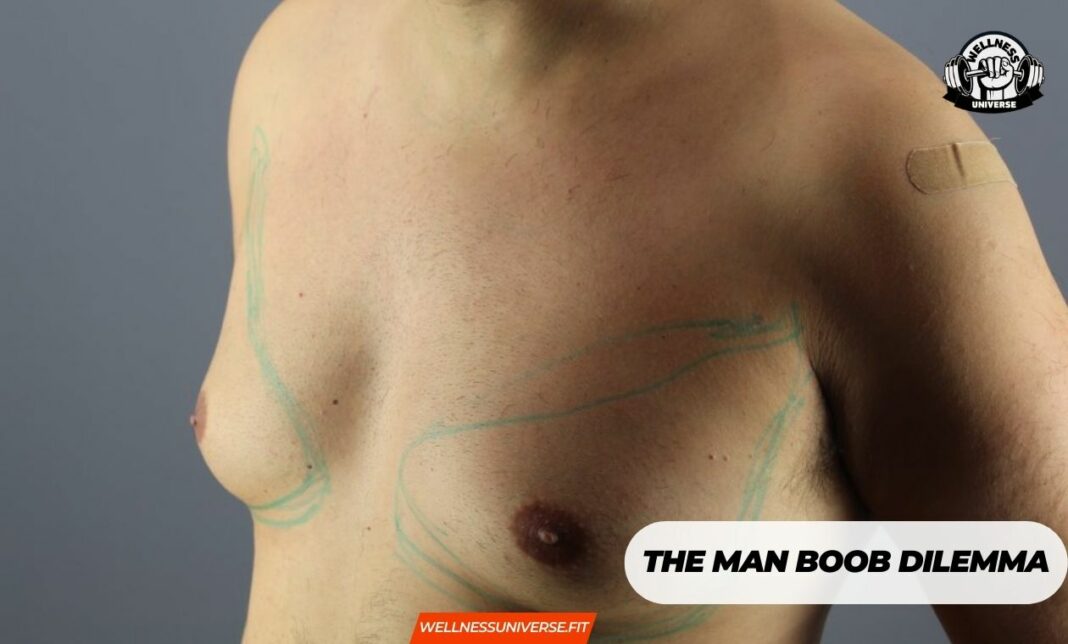Man boobs, medically known as gynecomastia, refer to the enlargement of breast tissue in men. This condition can manifest as an increase in the size of the chest area, giving it a more feminine appearance. Man boobs can have a significant impact on men’s physical appearance, self-confidence, and overall well-being. Many individuals with man boobs may experience embarrassment, self-consciousness, and a negative body image.
Understanding the causes and available solutions for man boobs is crucial for several reasons. Firstly, it helps men gain insight into why they may be experiencing this condition, reducing any feelings of isolation or confusion. Secondly, it empowers individuals to take appropriate action toward addressing the issue and regaining confidence in their bodies. By exploring the causes and solutions for man boobs, individuals can make informed decisions about the most suitable approach for their specific circumstances.
Man boobs can arise due to various factors, including hormonal imbalances, excess weight or fat deposition in the chest area, certain medical conditions, and medication side effects. It is essential to differentiate between gynecomastia, which involves the growth of breast tissue, and pseudogynecomastia, which refers to the accumulation of fat in the chest area without glandular growth. The causes of man boobs can vary from person to person, and understanding these causes is the first step towards finding appropriate solutions.
Let’s embark on this journey together, shedding light on man boobs and uncovering the path to a more fulfilling and confident life.
Understanding Man Boobs

Gynecomastia is a condition characterized by the enlargement of breast tissue in males. It is primarily caused by an imbalance in hormone levels, specifically an increase in estrogen or a decrease in testosterone. This hormonal imbalance leads to the growth of glandular tissue in the chest, resulting in the appearance of man boobs.
On the other hand, pseudogynecomastia refers to the accumulation of fat in the chest area without an increase in glandular tissue. It occurs when excess body fat is deposited in the chest, giving the appearance of enlarged breasts. Pseudogynecomastia is commonly associated with weight gain and obesity.
It is important to differentiate between gynecomastia and pseudogynecomastia because the underlying causes and treatment approaches can vary. Gynecomastia requires addressing the hormonal imbalance and potentially removing the excess glandular tissue, while pseudogynecomastia can often be improved through weight loss and lifestyle modifications.
Gynecomastia and chest fat may appear similar in terms of physical appearance, but they have distinct underlying causes. Gynecomastia is characterized by the growth of glandular tissue, resulting in a firmer and more rubbery texture in the chest area. It can be sensitive or tender to the touch.
On the other hand, chest fat is primarily composed of adipose tissue (fat cells). It tends to feel softer and more jiggly compared to the firmer texture of glandular tissue. Chest fat is often more responsive to lifestyle changes, such as exercise and diet, whereas gynecomastia may require medical intervention for optimal results.
It is common for individuals to have a combination of both gynecomastia and chest fat. In such cases, a comprehensive approach that addresses both hormonal imbalance and fat reduction is usually recommended for the best aesthetic outcome.
Hormonal imbalances play a significant role in the development of gynecomastia. The primary hormones involved are estrogen and testosterone. Normally, men have higher levels of testosterone, which is responsible for masculine characteristics, including muscle development and leaner body composition. Estrogen, on the other hand, is more predominant in females and contributes to breast development.
In cases of gynecomastia, there is an increase in estrogen or a decrease in testosterone, disrupting the hormonal balance. This imbalance can occur due to various factors, such as puberty, aging, certain medical conditions, medication side effects, or the use of anabolic steroids.
During puberty, hormonal fluctuations can lead to temporary gynecomastia in some males. In most cases, this condition resolves on its own as hormone levels stabilize. However, for some individuals, gynecomastia may persist or develop later in life.
Certain medical conditions, such as liver or kidney disease, hormonal disorders (e.g., hypogonadism, hyperthyroidism), and tumors, can also contribute to gynecomastia by affecting hormone levels.
In addition, the use of medications, including certain antidepressants, anti-anxiety drugs, antiretrovirals, and anabolic steroids, can disrupt the hormonal balance and contribute to the development of gynecomastia.
Understanding the role of hormonal imbalances in the development of man boobs is crucial for determining appropriate treatment options. By addressing the underlying hormonal factors, individuals can effectively manage and treat gynecomastia, leading to improved physical appearance and enhanced self-confidence.
Understanding Man Boobs
Gynecomastia is a condition characterized by the enlargement of breast tissue in males. It is derived from the Greek words “gyne,” meaning woman, and “mastos,” meaning breast. Gynecomastia can occur on one or both sides of the chest and may result in a more feminine-looking chest contour. It is important to note that gynecomastia is not the same as having excess chest fat, which is referred to as pseudogynecomastia.
Pseudogynecomastia, also known as false gynecomastia, is the accumulation of excess fat in the chest area without an increase in glandular breast tissue. It is commonly associated with weight gain and obesity. While both gynecomastia and pseudogynecomastia can cause an enlargement of the chest, the underlying causes and treatment approaches differ.
The key difference between gynecomastia and chest fat lies in the composition of the breast tissue. Gynecomastia is characterized by the proliferation of glandular breast tissue, resulting in a firm or rubbery feel under the nipple area. This growth is typically a result of an imbalance in hormone levels, specifically an increase in estrogen or a decrease in testosterone. The excess glandular tissue can give the appearance of breasts in men.
On the other hand, chest fat is primarily composed of adipose tissue or fat cells. Excess fat deposits in the chest region can lead to a soft or jiggly texture. Pseudogynecomastia, which is often related to weight gain, is primarily caused by an accumulation of chest fat. While it may create a similar appearance to gynecomastia, the underlying cause is different.
It is worth noting that individuals can have a combination of both gynecomastia and chest fat, where excess fat is present alongside the growth of glandular tissue. In such cases, a comprehensive approach that addresses both hormonal imbalance and fat reduction may be necessary for optimal results.
Hormonal imbalances play a significant role in the development of gynecomastia. The primary hormones involved are estrogen and testosterone. In males, testosterone is the dominant hormone responsible for masculine traits, such as muscle development and leaner body composition. Estrogen, predominantly found in females, is responsible for breast development.
In cases of gynecomastia, there is an imbalance between estrogen and testosterone levels, leading to the proliferation of breast tissue. This hormonal imbalance can be caused by a variety of factors. During puberty, hormonal fluctuations can temporarily trigger gynecomastia in some males. In most cases, it resolves on its own as hormone levels stabilize. However, in some individuals, gynecomastia may persist or develop later in life.
Several other factors can contribute to hormonal imbalances and the subsequent development of gynecomastia. These include certain medical conditions such as liver or kidney disease, hormonal disorders like hypogonadism or hyperthyroidism, and the presence of tumors. Additionally, the use of certain medications, including some antidepressants, anti-anxiety drugs, antiretrovirals, and anabolic steroids, can disrupt the hormonal balance and contribute to gynecomastia.
Understanding the role of hormonal imbalances in the development of man boobs is crucial in determining the appropriate treatment options. By addressing the underlying hormonal factors and considering individual circumstances, healthcare professionals can guide individuals toward effective management strategies, leading to improved physical appearance and increased self-confidence.
Causes of Man Boobs
Hormonal imbalances, particularly in estrogen and testosterone levels, are one of the primary causes of man boobs or gynecomastia. Normally, men have higher levels of testosterone, the male sex hormone, which promotes masculine characteristics and inhibits the growth of breast tissue. Estrogen, the female sex hormone, is present in smaller amounts in men. However, an imbalance between these hormones can disrupt the delicate hormonal equilibrium and lead to the development of man boobs.
In some cases, an increase in estrogen or a decrease in testosterone can occur naturally. During puberty, hormonal fluctuations may cause temporary gynecomastia as the body adjusts to hormonal changes. Most of the time, this condition resolves on its own as hormone levels stabilize. However, certain individuals may experience persistent or recurring gynecomastia due to ongoing hormonal imbalances.
Apart from natural hormone fluctuations, other factors can contribute to hormonal imbalances. Some medical conditions, such as liver or kidney disease, can disrupt hormone metabolism and result in increased estrogen levels or decreased testosterone levels. Hormonal disorders like hypogonadism (low testosterone production) or hyperthyroidism (overactive thyroid gland) can also contribute to the development of man boobs. These underlying hormonal causes require appropriate medical intervention for effective management.
Various medical conditions can contribute to the development of man boobs or gynecomastia. Understanding these underlying health issues is crucial for proper diagnosis and treatment. Some medical conditions associated with gynecomastia include:
- Obesity: Excess body fat can lead to increased estrogen production and the conversion of testosterone to estrogen, potentially resulting in gynecomastia.
- Klinefelter syndrome: This genetic disorder occurs when males have an extra X chromosome. It can cause hormone imbalances, including decreased testosterone levels, which can contribute to gynecomastia.
- Liver disease: Liver cirrhosis or other liver diseases can impair hormone metabolism and lead to elevated estrogen levels, promoting the growth of breast tissue.
- Kidney failure: When the kidneys are unable to function properly, hormonal imbalances can occur, including elevated estrogen levels, which can contribute to gynecomastia.
- Malnutrition: Severe malnutrition or deficiencies in certain nutrients can disrupt hormone production and balance, potentially leading to gynecomastia.
Identifying and addressing these underlying medical conditions is essential for effectively managing man boobs. In many cases, treating the underlying condition can help resolve gynecomastia or prevent its progression.
The use of certain medications can also contribute to the development of man boobs. Some medications have the potential to disrupt the hormonal balance, leading to gynecomastia as a side effect. These medications include:
- Anti-androgens: Medications used to treat prostate enlargement, prostate cancer, or other conditions may block the action of testosterone or reduce its production, potentially leading to gynecomastia.
- Anabolic steroids: The use of anabolic steroids, often abused by some athletes and bodybuilders to enhance performance, can disrupt the hormonal balance, causing gynecomastia.
- Anti-anxiety medications: Certain anti-anxiety medications, such as diazepam and lorazepam, have been associated with gynecomastia.
- Antidepressants: Some antidepressants, particularly selective serotonin reuptake inhibitors (SSRIs) like sertraline and fluoxetine, have been linked to gynecomastia as a possible side effect.
- Antiretroviral medications: Certain antiretroviral medications used in the treatment of HIV/AIDS can disrupt hormone levels and contribute to gynecomastia.
If you suspect that the medication you are taking may be causing gynecomastia, it is important to consult with your healthcare provider. They can evaluate your medication regimen and determine if alternative options are available that are less likely to cause gynecomastia or explore other management strategies.
Understanding the causes of man boobs, including hormonal imbalances, underlying medical conditions, and medication use, can help individuals identify potential factors contributing to their condition. This knowledge is crucial for effective treatment and management approaches tailored to each individual’s specific needs.
Exercise and Man Boobs
Exercise plays a crucial role in reducing man boobs and improving overall chest appearance. By targeting the chest muscles, individuals can strengthen and tone the pectoral region, which can help reduce the appearance of excess breast tissue. Incorporating a well-rounded exercise routine that includes both chest-specific exercises and overall body strength training and cardio exercises is key to achieving optimal results.
- Push-Ups: Push-ups are a classic and effective exercise that engages the chest muscles. They can be performed in different variations to target specific areas of the chest, such as wide-grip push-ups, close-grip push-ups, or decline push-ups.
- Dumbbell Bench Press: This exercise involves lying on a bench and pressing dumbbells upward. It primarily targets the chest muscles and can be adjusted by using different weights and angles.
- Chest Flyes: Chest flyes are performed using dumbbells or a cable machine. This exercise involves opening the arms wide, simulating a “fly” motion, and targeting the outer and inner chest muscles.
- Incline Bench Press: By adjusting the bench to an incline position, the incline bench press puts more emphasis on the upper chest muscles. It is an effective exercise to build strength and definition in the upper chest area.
- Cable Crossovers: Cable crossovers involve using cable pulleys to simulate a crossing motion in front of the body. This exercise targets the inner chest muscles and provides a good stretch to the pectoral region.
While targeted chest exercises are beneficial, it is important to emphasize the significance of overall body strength training and cardio exercises for reducing man boobs. Incorporating compound exercises that engage multiple muscle groups, such as squats, deadlifts, lunges, and rows, helps to increase overall muscle mass and boost metabolism. This, in turn, can aid in reducing overall body fat, including fat stored in the chest area.
Cardiovascular exercises, such as running, cycling, swimming, or HIIT (high-intensity interval training), are essential for burning calories and promoting fat loss. Engaging in regular cardio sessions not only contributes to overall weight loss but also helps to decrease body fat percentage, which can lead to a reduction in the appearance of man boobs.
It is important to note that exercise alone may not be sufficient to eliminate all cases of gynecomastia. In some instances, surgical intervention may be necessary, especially when the excess breast tissue is primarily glandular. Consulting with a healthcare professional or a certified fitness trainer can provide personalized guidance and recommendations based on individual goals and needs.
By incorporating chest-specific exercises, overall body strength training, and cardio exercises into a well-rounded fitness routine, individuals can enhance their chances of reducing man boobs and achieving a more sculpted and defined chest appearance. Remember, consistency and patience are key when it comes to seeing results from exercise, so stay committed to your fitness journey and enjoy the progress along the way.
Natural Remedies and Lifestyle Changes
Making certain dietary modifications can play a significant role in reducing man boobs by influencing hormone levels and fat distribution. Here are some key considerations:
- Eat a Balanced Diet: Focus on consuming a well-balanced diet that includes lean proteins, healthy fats, whole grains, and a variety of fruits and vegetables. This helps provide essential nutrients and supports overall hormonal balance.
- Limit Processed Foods and Sugars: Processed foods and foods high in added sugars can contribute to weight gain and hormonal imbalances. Minimizing their consumption can help reduce overall body fat, including fat in the chest area.
- Increase Fiber Intake: Fiber-rich foods, such as fruits, vegetables, whole grains, and legumes, can aid in digestion, promote satiety, and support weight management, which may indirectly help reduce man boobs.
- Include Healthy Fats: Incorporate healthy fats, such as avocados, nuts, seeds, and olive oil, into your diet. These fats provide essential nutrients and can help regulate hormone production and function.
- Stay Hydrated: Drinking an adequate amount of water throughout the day is essential for overall health and can support optimal hormone balance and fat metabolism.
While natural remedies and herbal supplements may be widely discussed, it is important to note that scientific evidence supporting their effectiveness in reducing man boobs is limited. It is always recommended to consult with a healthcare professional before incorporating any supplements into your routine. That being said, some commonly mentioned natural remedies and herbal supplements associated with reducing man boobs include:
- Green Tea: Green tea contains antioxidants and compounds that may help boost metabolism and aid in weight management.
- Turmeric: Curcumin, the active compound in turmeric, has been studied for its potential anti-inflammatory and antioxidant effects, which may have implications for reducing man boobs.
- Guggulsterones: Guggulsterones, derived from the Commiphora mukul tree, have been traditionally used in Ayurvedic medicine and are believed to support healthy hormone levels.
- Tribulus Terrestris: This herb is often marketed as a natural testosterone booster, although its efficacy and safety for reducing man boobs require further research.
It is crucial to exercise caution when considering natural remedies and herbal supplements, as their safety, quality, and potential interactions with medications may vary. Always consult with a healthcare professional before starting any new supplements.
Lifestyle factors play a significant role in hormone regulation, and making certain changes can contribute to overall hormonal balance, potentially impacting a man’s boobs. Consider the following:
- Manage Stress: Chronic stress can disrupt hormone levels, including those involved in fat metabolism and distribution. Incorporating stress management techniques such as exercise, meditation, deep breathing, and engaging in hobbies can help reduce stress and promote hormonal balance.
- Prioritize Sleep: Inadequate sleep can disrupt hormone production and metabolism. Aim for 7-9 hours of quality sleep each night to support overall hormonal health.
- Avoid Exposure to Environmental Hormone Disruptors: Certain chemicals found in plastics, pesticides, and personal care products may have hormone-disrupting effects. Minimizing exposure to these substances can contribute to better hormone balance.
- Maintain a Healthy Body Weight: Maintaining a healthy weight through a balanced diet and regular exercise can help regulate hormone levels and reduce excess body fat, potentially leading to a reduction in man boobs.
It is important to note that lifestyle changes and natural remedies may not eliminate all cases of gynecomastia. In cases where hormonal imbalances or glandular tissue growth are significant, medical intervention, such as hormone therapy or surgery, may be necessary. Consulting with a healthcare professional can provide personalized guidance and recommendations based on individual circumstances.
By adopting dietary modifications that support hormone balance, being cautious with natural remedies and herbal supplements, and making positive lifestyle changes, individuals may improve their overall hormonal health and potentially reduce the appearance of man boobs. Remember to consult with healthcare professionals for personalized advice and to approach natural remedies with caution.
In Crux
In conclusion, man boobs can be a source of concern and impact an individual’s physical appearance and self-esteem. However, it’s important to remember that there are steps you can take to address this issue and improve your confidence. By understanding the causes of man boobs, such as hormonal imbalances and chest fat, you can make informed decisions about the strategies that may work best for you.
Whether you choose to pursue exercises targeting the chest muscles, explore natural remedies and lifestyle changes, or seek medical advice, taking a proactive approach can lead to positive outcomes. It’s essential to remember that each individual is unique, and what works for one person may not work for another. Therefore, it’s important to experiment and find the strategies that suit your specific needs and goals.
While addressing man boobs is a valid goal, it is equally crucial to embrace and accept your body throughout the process. Remember that body diversity is natural and normal, and everyone’s journey is different. Celebrate the progress you make and appreciate the efforts you put into improving your overall well-being.
It’s important to recognize that man boobs can have both physical and emotional impacts. If you find yourself struggling with body image or experiencing emotional distress, seeking support is essential. Reach out to trusted friends, family members, or professionals who can provide guidance, encouragement, and understanding. Mental and emotional well-being is just as important as physical health, and addressing any concerns in these areas can contribute to a more holistic and positive outlook.
By taking proactive steps towards addressing man boobs, embracing your body, and seeking support when needed, you can embark on a journey towards greater self-confidence and improved well-being. Remember that change takes time, and progress may not happen overnight. Stay committed, be patient with yourself, and celebrate the small victories along the way.
Remember, you have the power to take control of your journey, make positive changes, and achieve your goals. Embrace your uniqueness, prioritize your well-being, and keep moving forward on the path to greater confidence and self-acceptance. You deserve to feel comfortable and confident in your skin.
Thank you for joining us on this fitness journey! We hope you found our The Man Boob Dilemma: Banishing the Bulge for Good blog insightful and inspiring. Our aim is to provide you with valuable information, expert advice, and motivational content to support you in your wellness endeavors.
Related Post :-
- How To Do Wall Pushups
- Batman Workout
- BMI Breakthrough
- Barbell Lunges
- Better Health
- Fight Club Workout
Man Boob Dilemma FAQs
How can I determine if I have gynecomastia or chest fat?
Gynecomastia is characterized by the growth of glandular breast tissue, whereas chest fat is primarily composed of adipose tissue. A medical professional can help you determine the exact cause through physical examination and diagnostic tests if necessary.
What are the treatment options for man boobs?
Treatment options for man boobs depend on the underlying cause. If the cause is a hormonal imbalance or medication-induced, addressing those factors may lead to improvement. In some cases, surgery may be recommended to remove excess breast tissue.
Can losing weight help reduce man boobs?
Yes, losing weight can help reduce the appearance of man boobs, especially if they are primarily due to excess chest fat. Incorporating a balanced diet and regular exercise can contribute to overall weight loss and fat reduction.
Are there specific exercises to target and reduce man boobs?
While spot reduction is not possible, exercises that target the chest muscles can help tone and strengthen the pectoral area. Some effective exercises include chest presses, push-ups, chest flies, and cable crossovers.
Are man boobs reversible through non-surgical methods?
In some cases, man boobs caused by chest fat can be reduced through non-surgical methods such as lifestyle changes, including exercise and a healthy diet. However, if the condition is primarily due to glandular breast tissue, surgery may be the most effective option.
Can hormonal imbalances contribute to the development of man boobs?
Yes, hormonal imbalances, specifically an increase in estrogen or a decrease in testosterone, can contribute to the development of man boobs. Conditions such as puberty, certain medical conditions, or the use of certain medications can disrupt hormonal balance.
Are there any natural remedies or lifestyle changes to reduce man boobs?
Adopting a healthy lifestyle that includes regular exercise, a balanced diet, stress reduction techniques, and adequate sleep can help improve hormonal balance and reduce excess body fat, potentially contributing to the reduction of man boobs.
When should I consider seeking medical advice for man boobs?
If you are concerned about the development of man boobs or if they are causing physical or emotional distress, it is advisable to seek medical advice. A healthcare professional can evaluate your specific situation, determine the underlying cause, and recommend appropriate treatment options.
Are man boobs a sign of breast cancer?
While rare, man boobs can, in some cases, be associated with breast cancer. However, the majority of cases are not cancer-related. If you have concerns, it's essential to consult with a healthcare professional who can perform a thorough evaluation and provide accurate diagnosis and guidance.

Meet Pradeep Singh, your go-to guide for all things fitness, health, and motivation. With over 7 years in the field, Pradeep brings a blend of expertise and real-world experience to his writing. From workout tips to healthy living insights, he simplifies complex topics, making fitness accessible for everyone. His authentic approach and genuine passion aim to inspire and support your wellness journey. Get ready to embark on a path to a healthier lifestyle with Pradeep as your trusted companion and motivator.






















